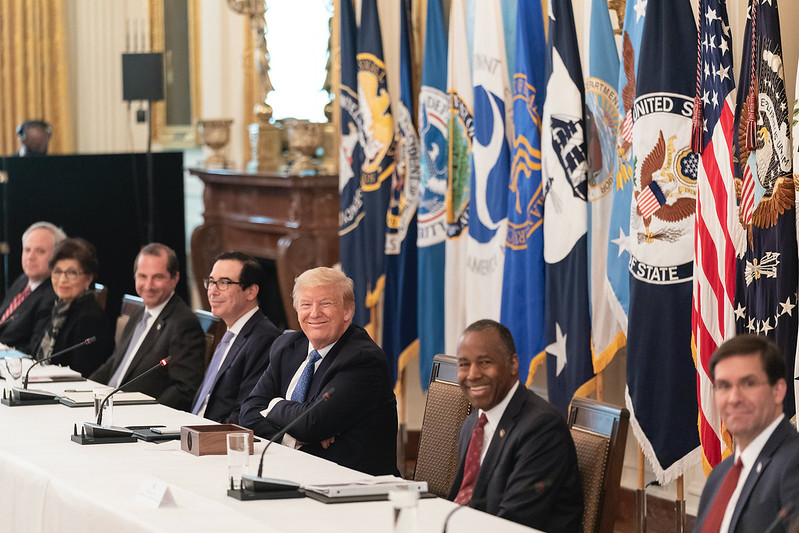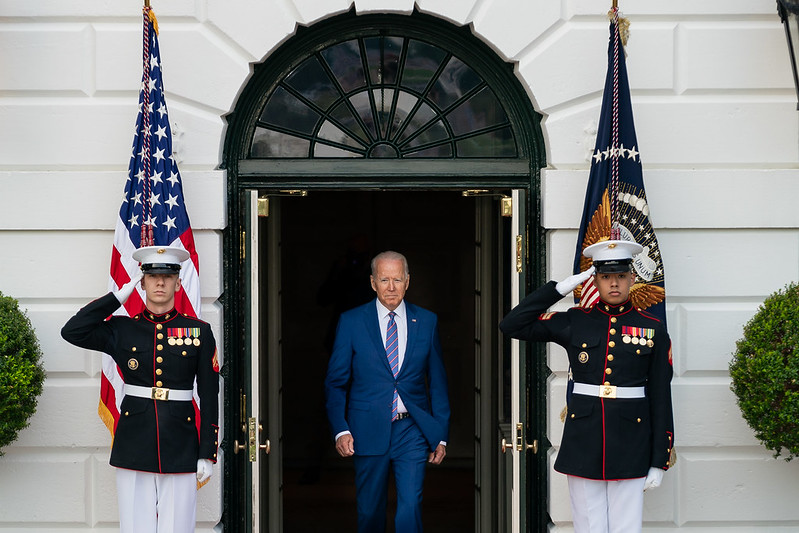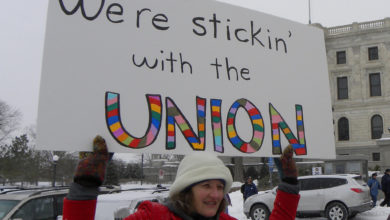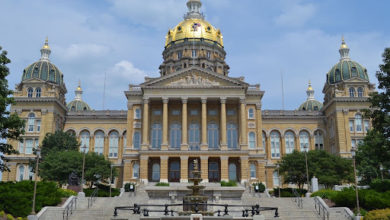Photo: Marine One, the official helicopter of the president, departs from the White House lawn. Public domain.
Every young person in America is taught in school about the wonders of the U.S. system of government — brilliantly designed to protect freedom, flexible enough to solve any problem, and given legitimacy by the consent of the governed. But this fairy tale version of U.S. politics bears no resemblance to reality.
In fact, these notions might seem so outlandish that many people’s eyes glaze over at the mere mention of the intricacies of how the government functions. But for those who want to put an end to this unjust order, it is absolutely essential to understand those intricacies. It is not necessary to grasp the ins-and-outs of the Constitution or the legislative process to come to the conclusion that the system has to end — but to actually bring about this profound transformation of society we need to know in detail how our enemy operates.
Liberation News is producing the “Civics Class for Radicals” series to shine light on the reality of this system of government of, by and for the rich.
Read Part 1 on the Supreme Court here, and Part 2 on Congress here.
Of all the capitalist states in the world, the U.S. government stands unmatched in its contempt for the needs of working people, the vast scope of its power and its capacity for violence. At the very top of this apparatus is a single person: the president. The authority invested in this office is immense and constantly growing.
The president is the head of the executive branch of the government. Karl Marx’s observation in the Communist Manifesto in 1848 is just as true today as it was then: “the executive of the modern state is but a committee for managing the common affairs of the bourgeoisie.” Rather than advancing the interests of particular sectors of capital or individual capitalists, the executive branch of the state is meant to take action to maintain the overall stability of the capitalist system and its capacity to grow.
The 46 men who have occupied the office of president of the United States wielded this power to shape the course of world history — and commit some of its worst atrocities.
The executive branch agencies
The vast authority of the executive branch is organized into different departments with a more particular mission. Each department ultimately answers to the president.
At its core, the state is an institution of organized violence, and several cabinet secretaries are tasked with managing it. The Department of Defense, headquartered at the Pentagon, is in charge of the military. The State Department handles the softer side of imperialist “diplomacy.” The Department of Justice enforces federal law, administers the federal prison system and is in charge of the FBI. The Department of Homeland Security was created after the September 11 attacks to centralize many of the disparate repressive functions of the government — border patrol, ICE, the Coast Guard and others. DHS is also in charge of FEMA, the federal disaster relief agency.
Other executive branch departments deal with the economy. Most importantly, the Department of the Treasury is responsible for collecting revenue for the government and disbursing it. It is the only entity allowed to print dollars, it issues bonds and pays government debt, and controls the IRS. The Treasury Department has also played an increasingly prominent role in U.S. aggression around the globe by enforcing sanctions through its Office of Foreign Asset Control. There is a separate Department of Commerce that deals with matters related to foreign trade, regulates “intellectual property” through the Patent and Trademark Office and conducts the Census. The Department of Energy and the Department of Transportation deal with government policy relating to these two sectors that are so crucial to the day-to-day operation of capitalism. The Department of the Interior manages the vast landholdings of the U.S. government and is in charge of policy relating to Indigenous peoples.
There are several cabinet agencies that were created to administer social programs and related policies created by the government over the years as concessions to people’s movements. However, the departments themselves are sometimes associated with the onerous bureaucracy that people have to navigate. These include the Departments of Labor, Education and Housing and Urban Development. The Department of Health and Human Services is most well-known for administering Medicare and Medicaid.
HHS also used to be in charge of the Social Security Administration, but it became an independent agency in 1994. Independent agencies are government bodies that are technically part of the executive branch, but not under the authority of a cabinet secretary. This includes the CIA, the Environmental Protection Agency, and regulatory bodies like the Securities and Exchange Commission and the Federal Communications Commission.
Each department is led by a secretary who is nominated by the president and confirmed by the Senate. In many cases Senate confirmation is a relatively uneventful affair, but in others it can be an opportunity for the opposing party to score political points by digging up dirt on a nominee and releasing it in the run up to a final vote. In any case, senators who are members of relevant committees have an opportunity to publicly question nominees.
The secretary of a department is the highest ranking example of a political appointee. A political appointee is an official who is installed by the current administration in order to develop and execute its political program. They are typically replaced when one administration ends and another begins.
Some political appointees are chosen for their expertise in particular matters — the ruling class does want their system to be well-managed, after all — but very frequently appointments are used to repay political (or even personal) favors. The month after his tenure as vice president ended, Joe Biden was given a highly lucrative position at the University of Pennsylvania as the “Benjamin Franklin Presidential Practice Professor” — a fake job that essentially involved giving a handful of speeches from 2017 to 2019, for which he was paid over $910,000. When Biden became the president, he rewarded Amy Guttman, the university president who gave him the job, by naming her the U.S. Ambassador to Germany. Donald Trump named Betsy DeVos to be Secretary of Education even though she has no professional background in education whatsoever. This was obviously a reward for her powerful billionaire family’s bankrolling of Republican candidates, which amounted to over $10 million in the 2016 election cycle alone.
Other officials in executive branch agencies are called career civil servants. They are professional administrators whose work in the government is not dependent on which administration or party is in power. At the lower levels, career civil servants are public sector workers whose personal interests may be totally at odds with those of the institutions where they work. But high-ranking career civil servants form part of the permanent apparatus of the state, ensuring the efficient functioning of the government in the interests of the ruling class.

Setting the domestic political agenda
As the most powerful single leader in the entire capitalist state, the president is in a position to set the tone for U.S. politics overall. Through their public statements and initiatives, the president can exercise a great deal of influence over which issues receive the most attention from both the public and the ruling class.
The White House’s press secretary leads a staff aimed at influencing the mass media and is a cornerstone of an even broader communications operation. Every year, the president gives a speech to a joint session of Congress called the State of the Union address, which lays out the administration’s key goals for the year. But if a president becomes deeply unpopular or their power is otherwise diminished, other leaders of the state may try to take the initiative away and set the national agenda themselves — like Speaker of the House Newt Gingrich attempted in the 1990s with his ultra-right “contract with America” program.
The president does not have the authority to directly introduce legislation. However, if Congress is led by the same party as the president’s, then the White House and congressional leadership often works together to craft bills and get them passed. If Congress passes a law that the president opposes, then the president can veto that law — meaning they refuse to sign it. Congress can override the president’s veto and pass a bill into law anyway, but only if both chambers vote with a two-thirds majority to do so.
Short of legislating, the president does have the authority to issue executive orders. These official decrees are legally binding and can be highly consequential — for instance, segregation in the armed forces was abolished by executive order. However, they are not unlimited in scope. An executive order must be justified on the basis of either the constitutional authority invested in the presidency or a law passed by Congress that delegates the authority in question to the executive branch.
Executive orders can be, and frequently are, challenged in court. Federal courts have the power to rule on whether or not the president overstepped their authority, and also have the option of issuing a temporary “stay” pausing the implementation of the policy in question until the judicial process plays out. But this oftentimes is simply about resolving power struggles between ruling-class centers and preserving the authority of Congress, not protecting the rights of the people. Take for example Executive Order 12333, issued in 1981 by Ronald Reagan. It is the legal foundation for the modern-day mass surveillance state. EO 12333 authorized the bulk collection of information obtained through “foreign intelligence, counterintelligence, international narcotics or international terrorism investigation” as well as “incidentally obtained information that may indicate involvement in activities that may violate federal, state, local or foreign laws.” This extremely broad definition — issued by decree without any act of Congress — is obviously a violation of constitutional protections from unreasonable search and seizure, and yet it remains legally in force.
War and repression
The power of the presidency has expanded over time, especially as the United States emerged as the leading imperialist power. The power of U.S. capitalism is based on overwhelming violence imposed at home and abroad. On matters of war and repression, the president takes the lead.
The president is the Commander in Chief of the military, who all uniformed officers are supposed to obey no matter how high ranking. However the Constitution is explicit that only “The Congress shall have Power To … declare War.” However, in practice the president has wide latitude to wage war around the world on their own initiative. The last time a formal declaration of war was issued was during World War II. Since then, congressional resolutions, often called “authorization for the use of military force,” have largely taken their place.
These acts of Congress, whether they are resolutions or official declarations of war, are supposed to impose limits on the scope of the conflict, thus restricting the president’s powers. But 63 percent of them throughout U.S. history did not specify the types of military force that can be used, 77 percent did not include a date at which point the authorization expires, and 57 percent did not even name the enemy that the war was supposed to be waged against!

Presidential administrations frequently employ convoluted legal rationales to stretch the mandates to wage war they receive from Congress. Take the 2001 Authorization for the Use of Military Force passed after the September 11 attacks. It was widely understood to be an authorization to fight al-Qaeda, and in fact the full name of the resolution is “Joint Resolution to authorize the use of United States Armed Forces against those responsible for the recent attacks launched against the United States.” But far from being strictly contained to action against the perpetrators of 9/11, the 2001 AUMF has been used to justify U.S. military interventions in Afghanistan, Iraq, Libya, Pakistan, Somalia, Yemen and Syria. Syria may have been the most ridiculous example of all — this instance related to the U.S. bombing campaign against ISIS, an organization that was actually in a state of war with al-Qaeda at the time! Donald Trump cited the 2002 AUMF that authorized the following year’s invasion of Iraq to justify his decision to assassinate Qasem Soleimani — a top general from Iran who in fact rose to prominence as a commander in combat against the Iraqi military during Saddam Hussein’s rule.
The invention of atomic weapons added a new, previously unthinkable power to the presidency — the unchecked authority to wage nuclear war. The president alone has the power to order a nuclear strike and does not need to seek the approval or even advice of any other official. At all times, there is a military officer assigned to accompany the president wherever they are with a briefcase holding a machine called “the football”, essentially a high-tech communications device that allows the order to launch an attack to be transmitted to all the necessary personnel. Perhaps nothing says as much about the power of the president as the fact that there is a person whose job is to follow him around with a device used to annihilate all human life on earth, so it is immediately on hand in case he decides to kill everyone on the planet.
To retain its wealth and power, the ruling class of the United States employs violence not only abroad, but domestically as well. This too is the domain of the presidency. The president, by virtue of their leadership of the executive branch agencies, can issue orders to all of the federal police and intelligence agencies and coordinate their efforts to repress people’s movements for change.
Take for example the massive crackdown on the 2020 uprising against racism, which saw millions of people take to the streets to protest police murder of Black people and the entire white supremacist order in society. Donald Trump mobilized forces from agencies like the Federal Bureau of Prisons, the U.S. Marshals Service, Drug Enforcement Administration, and the Bureau of Alcohol, Tobacco and Firearms to attack demonstrators. This includes the infamous assault on demonstrators in Lafayette Park across the street from the White House on June 1 to clear a path for Trump to give a press conference in front of a nearby church, and the deployment to Portland of federal police who kidnapped protesters in unmarked vehicles. To provide a legal rationale for this crackdown, Trump issued Executive Order 13933, justifying the policy in part on the basis that many protesters “have explicitly identified themselves with ideologies — such as Marxism — that call for the destruction of the United States system of government.”
But it is not only undisguised, ultra-reactionary figures like Trump who wield the power of the presidency in this way. The Obama administration also directed a nationwide anti-protest crackdown, targeting the Occupy Wall Street movement. In a scheme exposed in documents made public by the Partnership for Civil Justice Fund, a nationwide network of “fusion centers” — set up ostensibly for counter-terrorism purposes to coordinate between federal and local police and intelligence agencies – surveilled every detail of the Occupy encampments. Then, in a sweeping crackdown that was obviously centrally coordinated, local police agencies moved in on Occupy encampments across the country in November, dispersing the movement.
The brutality, cruelty and greed of the entire capitalist government is personified in one individual: the president, who gives executive leadership not only to the capitalist class of this country but the entire global system dominated by the U.S. empire. The power of this office is curtailed only so far as is necessary to protect other ruling class power centers. But towards oppressed people in the United States and around the world, the president has license to exercise tyranny.






